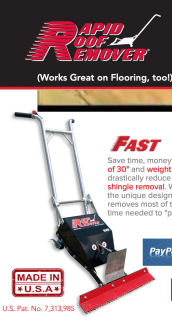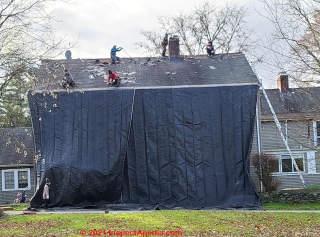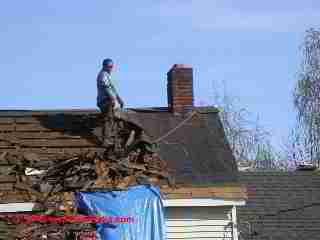 Asphalt Shingle Tear-Off Tools
Asphalt Shingle Tear-Off Tools
Manual & machine-powered or air powered shingle strippers work on other roofs too
- POST a QUESTION or COMMENT about re-roofing, tear-off, shingle-over with asphalt roof shingles
Asphalt roof shingle re-roofing, when it's necessary to remove one or more layers of existing shingles or other roofing material, is far easier and faster if you use an appropriate shingle stripping tools.
This article series discusses asphalt shingle roof-over or re-roofing with new asphalt shingles.
InspectAPedia tolerates no conflicts of interest. We have no relationship with advertisers, products, or services discussed at this website.
- Daniel Friedman, Publisher/Editor/Author - See WHO ARE WE?
Asphalt Shingle Roof Stripper Tools
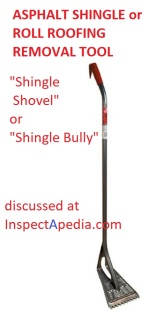 Tools for tearing off roof shingles & other roof covering systems
Tools for tearing off roof shingles & other roof covering systems
Asphalt shingle roofs use normal carpentry & roofing tools including a few flat bars; when pulling up a lot of shingles roofers use a stripping tool but typically one can get by with a short-handled flat-bladed shovel; the added width of the blade can reduce un-wanted shingle damage.
There is also a special roof shingle stripping tool sold for that purpose - it looks a bit like an adze with a notched blade, and there are also machine-operated roof stripping tools used in commercial roofing.
The notched blade of the shingle removal "shingle shovel" or (from Bully Tools) "shingle bully" helps the user drive the shovel edge under roofing nails to pull the nails up out of the roof sheathing as the shingles are being stripped.
Occasionally I'll use a slater's nail cutting tool - that's a long flat bar with notches - the tool can be driven up under shingles and then hammered down to cut nails. You shouldn't need that for repairing a valley.
Where to Buy Hand-Operated Shingle Removal Tolls
These manual (hand operated) shingle stripping tools are sold at building supply stores like Home Depot, some hardware stores, at roofing suppliers, and from online vandors.
- Bully Tools produces several models of shingle removal tools in the $40. - $50. U.S. price range.
- HDX 47.5 in. Roof Shovel Shingle Remover - Roof Ripper $40.
- Malco SB48AE Shingle REmoval Tool - heavy duty, widespread notches, about $90. U.S.
- MBI Shingle Stripper, from MBI Tools, 46" overall length, steel notched shingle strippr "shovel", light weight, wide, under $50. U.S. also available in a short 24-inch model for working in tight spots.
- Rapid Roof Remover - shown below, is a hybrid: a manually operated shingle stripper that adds a pneumatic jack to lift larger areas of roof material (or flooring) - see Rapid Roof Remover® 241 W Oak St. Washington C.H. Ohio 43160 740-505-9295 mobile 740-335-3443 office Website: https://www.rapidroofremover.com/ - JKN Enterprises of W.C.H. LLC.
- Razor bar, roof shingle stripping shovel
- Red Ripper D-handle shingle remover shovel, 52" long, asphalt shingle stripper also available in a 27-inch handle model.
- Roof Zone multi-handled "ergonomic" shingle remover - about $85.
- Shingle Eater 6127 from Shingle Eater, a strong steel shingle ripper tool (yellow) for under $60. U.S.
- Qualcraft produces a 54-inch Shingle Removal Shovel #2560P (shown here) priced on Amazon in 2019 at about $150. U.S.
Where to Buy or Rent Air or Motor-Powered Shingle Removal Tools
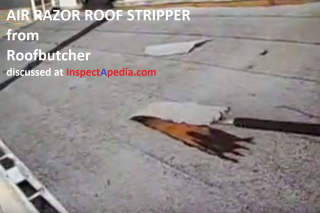 Commercial and other larger roofing jobs merit use of a powered shingle stripper, also sometimes called a roof spud machine or cutting machine, operated by air (pneumatic shingle strippers), electricity, gas. Some of these roof stripping machines are also available from equipment rental companies.
Commercial and other larger roofing jobs merit use of a powered shingle stripper, also sometimes called a roof spud machine or cutting machine, operated by air (pneumatic shingle strippers), electricity, gas. Some of these roof stripping machines are also available from equipment rental companies.
Watch out: most (though perhaps not all) of these shingle tear off machines are suitable for low slope (asphalt shingle or roll roofing) or flat roofs. They are not likely to be usable nor safe on steep sloped roofs.
Illustration: snapshot from Air Razor (Roofbutcher) roof stripper demonstration video, cited in detail just below. [Click to enlarge any image]
- Air-Razor-Roof Stripper, a pneumatic-assisted roof stripper, 5 hp.customerservice@strippingiron.com
sales@strippingiron.com
Roofbutcher
271B Main St.
Somersworth, NH 03878 Website: http://www.strippingiron.com/Air%20Razor.htm
demonstrated at this YouTube video - source of the image above https://www.youtube.com/watch?v=8adWzQlJGoY - Air Ripper, 5 hp. roof tear off machine - about $200. U.S. if you can find it at http://roof-shingle-removal-tool.com
- Demolition Demon roof stripper, in some roofing reviews, in 2019 this product was impossible to locate
- Lil-Doozie shingle stripper / shingle peeler: MatriX Evolutions Inc., 1635 rue St. Denis, Sorel-Tracy, Quebuec, Canada J3R 2A8, Tel: 450-517-3131 in Canada, or in the U.S. Roofers' Helpers LLC, PO Box 170, Milton, Vermont 05468, Email: rob@roofershelpers.com Website: http://shinglespeeler.net or roofershelpers.com in the U.S.
You'll also find online a useless YouTube video shows the machine in operation but gives no company contact information. - Rapid-Roof-Remover, pneumatic stripper, works best if the roof surface is pre-scored: see Rip Cart in this list. Rapid Roof Remover® 241 W Oak St. Washington C.H. Ohio 43160 740-505-9295 mobile 740-335-3443 office Website: https://www.rapidroofremover.com/
- Rip Cart, a wheeled circular saw used to slice through roofing to permit an opening line through which to use a manual or powered shingle stripping tool (probably unnecessary at most jobs - Ed. )
Available from several sources including Big Rock Supply, a division of Frank P. Frey & Co., 330 Meyer Road Bensenville, Illinois 60106 (800) 859 - 4077 contact@bigrocksupply.com Website: https://www.bigrocksupply.com/ripcart.htm - Roof Razor air powered roof stripping machine, Klai Enterprises Inc., USA, Klai Enterprises PO Box 43 Garden City, Michigan 48136-0043 Phone: 734.467.9906 Fax: 734.467.7712 Email: Jack@RoofRazorLLC.com Ron Matta Roof Razor VP Sales & Marketing Phone: 480.980.0639 Email: Ron@RoofRazorLLC.com website: http://www.roofrazorllc.com/
- Shingle Hog, air powered roof stripping machine, requires separate air compressor capable of delivering 90 psi. TBD2, 1424 Dewey St. PO Box 2140 Manitowoc, WI 54221-2140 920.482.1156 Website: http://www.towsleys.com/shinglehog/default.aspx
- Shingles Peeler, self-propelled shingle stripper cuts 12" strips of shingles or other roof covering material. See contact details at Lil-Doozie above. Website: www.shinglespeeler.net
 Illustration: a power roof strioper, the Grun Roof Stripper Turbo, also distributed through TechnoBuild & detailed below.
Illustration: a power roof strioper, the Grun Roof Stripper Turbo, also distributed through TechnoBuild & detailed below.
- Grun ROOF STRIPPER TURBO [PDF], is a gasoline (petrol) operated roof stripping machine - shown above - that uses a 9.5 hp motor. The wide stripper plate cuts a 60 cm swath through roofing materials. The manufacturer is a German firm: GRÜN GmbH
Spezialmaschinenfabrik
Siegener Str. 81 - 83
57234 Wilnsdorf - Niederdielfen
Phone: +49 271 - 39 88-0
E-Mail: info@gruen-gmbh.de
Excerpt from the company's website:
For peeling of roof sheeting and roof insulants like poly styrene plates, PU plates, cork plates and so on. The Roof Stripper Turbo with driving gear strips the roof sheeting cut off the base. The powerful motor 2400 W/230 V AC is equipped with starting current limiter and drives the travelling gear and the percussive mechanism.
The high number of strokes (5.000 strokes/min.) and an extremely strong bearing guarantee trouble free operation.
The travelling gear can be connected and disconnected by means of a coupling. Because of the compact design and an effective distribution of weight combined with optimum handiness the work can be done with minimum effort.
by means of the bow-type guide bar the stripped roof sheeting are thrown rightwards beside the machine. Stripping width approx. 40 – 50 cm, travelling speed approx. 1.000 m/h. The equipment is dismountable, can be easily transported and is suitable for universal use.
In the UAE contact Technobuild (who don't bother to mention that this machine is produced by Grun) at +9714 321 1145 Email: admin@gargash.biz European supplier, the Technobuild Construction Machinery LLC, company's website does not disclose the country or city of origin, but the website indicates the company is in the United Arab Emirates.
In order to absolutely assure our readers that we write and report without bias we do not sell any products nor do we have any business or financial relationships that could create such conflicts of interest.
InspectAPedia is an independent publisher of building, environmental, and forensic inspection, diagnosis, and repair information for the public - we have no business nor financial connection with any manufacturer or service provider discussed at our website.
Below: the asphalt shingles on this New York building were removed by a work crew who first took care to set a tarp to protect the lower building walls from falling debris.
When is it Forbiden or even Dangerous to Roof-Over Types of Existing Roof Coverings?
If a building roof is structurally sound, most building codes allow for two layers of asphalt shingles and some allow for a third on roofs with a 5:12 or steeper pitch.
Roofs that already have two layers of 2 shingles should not be roofed again. Remove the existing shingles, then roof with
new shingles. - FHA Single Family Housing Policy Handbook, cited atReferences or Citations
The question of when is it necessary to tear-off an existing roof-covering vs. when is roofing-over an option for a leaky roof is one of a sickening amount of argument.
- Strip Hard-Roof-Coverings: Model building codes address the easy part of the question: we do not put a new layer of roofing material over rotted, damaged roof decks, nor over wet roofing, nor over hard-material roofing such as slate, fiber cement, clay tiles, or wood shake roofs. [IBC 1510.3].
- Limit Number of Roof Covering Layers: Local building departments in many jurisdictions will permit multiple layers of some but not all roofing materials. Most won't permit more than three layers of asphalt shingles on a roof.
The issues are with nailing security, wind uplift, shorter life of asphalt materials over an uneven surface, effects of moisture trapped between roof layers, and possibly fire and roof covering weight loading safety concerns. - Threshold of Percent of Damage or Worn-Out Roof: Roofing contractors often will opine that if 25% or more of the roof area is at or beyond end of life then it is more-economical and smarter to tear off the existing roof, replace any questionable roof decking (and framing), and install a new roof.
The contractor won't want to warrant the entire roof against leaks if she is repairing only a limited area of it. - OPINION: strip off very rough existing roofing, even if it's just a single layer, if the existing roofing is in such rough, un-even, or poor condition that the new roof materials will not lie flat.
Lumpy asphalt roofing surfaces will usually wear faster at the convex or upper surfaces of bulges as the new shingles bend over an obstruction, and concave roofing shingle areas might wear unevenly too if the concavity is enough to slow shingle drainage or dryout after a rain. - Remove existing shingles over areas of prior leakage: unless inspection from below, say from an attic, makes you completely confident that the roof decking is sound, not rotted, soft, or delaminated, you may need to remove shingles over areas of prior leaks or suspected prior leaks (eaves, valleys, chimneys, soft spots) to inspect and if necessary replace marginal or damaged roof decking.
Otherwise your new shingles, poorly nailed to soft or rotted roof deck, may simply blow off at the first good wind.
Watch out: Check roof deck condition: if you are stripping roof shingles entirely from a roof deck, either because of their poor and rough-surface condition (not suitable to shingle-over), or because portions of the roof deck itself need to be replaced (perhaps due to rot, insect damage, water damage), be sure that you properly identify the type of roof sheathing used and its condition over the entire roof deck.
Don't even think about roofing-over a structure whose roof deck is in the condition shown in our photograph at left. But a careful inspection may be required to detect more subtle but dangerous roof deck conditions.
Watch out: Life Safety Issues: Walking on an old water-damaged roof with an un-sound roof deck can result in serious injury if a worker steps into a soft area and falls through the roof - a hazard more likely with thin plywood sheathing (on some low-cost homes as thin as 3/8" or even 1/4") and also more likely where the roof is known to have been leaking, or finally, where fiberboard roof sheathing has been used.
Roof deck fall through report: In the 1980's when we [DJF] were working on a roof-over job for a 1960's house we had observed from the building attic that thin 1/4" plywood had been used for roof sheathing and we already had a concern about the nail-holding ability of that material to prevent a roof blow-off.
We had also seen evidence of prior leaks on the north slope of the roof. But we failed to spot badly damaged roof sheathing in one area of the roof. After our in-attic inspection, our worker who weighed the least, D. S., was walking over one slope of this modestly-pitched hipped roof when she stepped right through a section of soft roof decking.
Luckily D. S. was not hurt, but a fall off or fall-through injury could have been very serious.
Asphalt Shingle Re-Roof Tear-Off Research
- "ROOF SHINGLE TEAROFF PROCEDURES for Homasote Products", [PDF] Homasote Co., 932 Lower Ferry Road, West Trenton, New Jersey 08628-024, U.S.A. 800-257-9491 website: at www.homasote.com
- "WHEN REROOFING SHOULD YOU TEAR OFF or RE-COVER?", [PDF] Thomas L. Smith, AIA, CRC, Professional Roofing,[date tbd, p. 54], Professional Roofing Magazine, O'Hare International Center, 10255 W. Higgins Road, Suite 600, Rosemont, IL 60018-5607, Telephone: (847) 299-9070, E-mail: professionalroofing@professionalroofing.net. Professional Roofing Magazine is a publication of NRCA, the National Roofing Contractors Association. [Permission requested 9/26/10].
- See ROOF SHINGLE TEAR-OFF PROCEDURE FOR HOMASOTE PRODUCTS [PDF], reproduced with permission of the Journal of Light Construction.
More about fiberboard roof and wall sheathing is at FIBERBOARD SHEATHING, Celotex Homasote & Other . - See "WHEN REROOFING, SHOULD YOU TEAR OFF OR RECOVER?" [PDF copy] Thomas L. Smith, director of NRCA's technology and research, originally published by the NRC's Professional Roofing magazine.
This article concludes that in some roof jobs a roof re-cover approach can be a viable operation and re-covering existing roof surfaces has been successfully used on many roof jobs, but it involves greater risks than a tear-off. The author points out that some roofing industry trade publications cite the roof-over option as a means of reducing waste disposal costs, but the author points out some concerns with roof-over re-roofing jobs in some conditions, including- life safety issues (as we explain above)
- leaving high-moisture-content insulation in place when re-roofing
- the structure may lack adequate strength to support the weight of an additional layer of roof covering
- Also seeReferences or Citations below
...
Continue reading at ASPHALT SHINGLE INSTALLATION or select a topic from the closely-related articles below, or see the complete ARTICLE INDEX.
Or see these
Recommended Articles
- ASPHALT ROOF SHINGLES - home
- ASPHALT SHINGLE INSTALLATION
- ASPHALT SHINGLE RE-ROOF GUIDE
- ASPHALT SHINGLE REMOVAL TOOLS
- ASPHALT SHINGLE UNDERLAYMENT SPECS
- ATTIC MOLD ROOF TEAROFF
- ROOF LEAK DIAGNOSIS & REPAIR
- SHINGLE EXPOSURE AMOUNT
- WARRANTIES for ROOF SHINGLES
- WIND DAMAGE to ROOFS
Suggested citation for this web page
ASPHALT SHINGLE REMOVAL TOOLS at InspectApedia.com - online encyclopedia of building & environmental inspection, testing, diagnosis, repair, & problem prevention advice.
Or see this
INDEX to RELATED ARTICLES: ARTICLE INDEX to BUILDING ROOFING
Or use the SEARCH BOX found below to Ask a Question or Search InspectApedia
Ask a Question or Search InspectApedia
Try the search box just below, or if you prefer, post a question or comment in the Comments box below and we will respond promptly.
Search the InspectApedia website
Note: appearance of your Comment below may be delayed: if your comment contains an image, photograph, web link, or text that looks to the software as if it might be a web link, your posting will appear after it has been approved by a moderator. Apologies for the delay.
Only one image can be added per comment but you can post as many comments, and therefore images, as you like.
You will not receive a notification when a response to your question has been posted.
Please bookmark this page to make it easy for you to check back for our response.
IF above you see "Comment Form is loading comments..." then COMMENT BOX - countable.ca / bawkbox.com IS NOT WORKING.
In any case you are welcome to send an email directly to us at InspectApedia.com at editor@inspectApedia.com
We'll reply to you directly. Please help us help you by noting, in your email, the URL of the InspectApedia page where you wanted to comment.
Citations & References
In addition to any citations in the article above, a full list is available on request.
- ARMA - Asphalt Roofing Manufacturer's Association - Asphalt Roofing Manufacturer's Association - https://www.asphaltroofing.org/ 750 National Press Building, 529 14th Street, NW, Washington, DC 20045, Tel: 202 / 207-0917
- ASTM International, 100 Barr Harbor Drive, PO Box C700, West Conshohocken, PA, 19428-2959 USA The ASTM standards listed below can be purchased in fulltext directly from http://www.astm.org/
- HUD, FHA Single Family Housing Policy Handbook, Title II Insured Housing Programs Forward Mortages, 203(k) consultant p. 5 (08/29/2014), retrieved 2018/02/17, original source: https://www.hud.gov/sites/documents/SFH_POLI_203K_CSL.PDF
- NRCA - National Roofing Contractors Association - Website: www.nrca.net 10255 W. Higgins Road, Suite 600, Rosemont, IL 60018-5607, Tel: (847) 299-9070 Fax: (847) 299-1183, Office hours: 8 a.m. to 5 p.m. CST
- UL - Underwriters Laboratories - https://www.ul.com/
2600 N.W. Lake Rd.
Camas, WA 98607-8542
Tel: 1.877.854.3577 / Fax: 1.360.817.6278 E-mail: cec.us@us.ul.com - Our recommended books about building & mechanical systems design, inspection, problem diagnosis, and repair, and about indoor environment and IAQ testing, diagnosis, and cleanup are at the InspectAPedia Bookstore. Also see our Book Reviews - InspectAPedia.
- Best Practices Guide to Residential Construction, by Steven Bliss. John Wiley & Sons, 2006. ISBN-10: 0471648361, ISBN-13: 978-0471648369, Hardcover: 320 pages, available from Amazon.com and also Wiley.com. See our book review of this publication.
- Decks and Porches, the JLC Guide to, Best Practices for Outdoor Spaces, Steve Bliss (Editor), The Journal of Light Construction, Williston VT, 2010 ISBN 10: 1-928580-42-4, ISBN 13: 978-1-928580-42-3, available from Amazon.com
- The Journal of Light Construction has generously given reprint permission to InspectAPedia.com for this article. All rights and contents are ©Journal of Light Construction and may not be reproduced in any form.
- Architectural elements: the technological revolution: Galvanized iron roof plates and corrugated sheets; cast iron facades, columns, door and window caps, ... (American historical catalog collection), Diana S Waite, available used out of Amazon.
- Asphalt Roofing Residential Manual from ARMA the Asphalt Roofing Manufacturers Association Website https://www.asphaltroofing.org/product/residential-asphalt-roofing-manual/ ,
- Building Pathology, Deterioration, Diagnostics, and Intervention, Samuel Y. Harris, P.E., AIA, Esq., ISBN 0-471-33172-4, John Wiley & Sons, 2001 [General building science-DF] ISBN-10: 0471331724 ISBN-13: 978-0471331728
- Building Pathology: Principles and Practice, David Watt, Wiley-Blackwell; 2 edition (March 7, 2008) ISBN-10: 1405161035 ISBN-13: 978-1405161039
- Green Roof Construction and Maintenance, Kelley Luckett, McGraw-Hill Professional, 2009, ISBN-10: 007160880X, ISBN-13: 978-0071608800, quoting: Key questions to ask at each stage of the green building process Tested tips and techniques for successful structural design Construction methods for new and existing buildings Information on insulation, drainage, detailing, irrigation, and plant selection Details on optimal soil formulation Illustrations featuring various stages of construction Best practices for green roof maintenance A survey of environmental benefits, including evapo-transpiration, storm-water management, habitat restoration, and improvement of air quality Tips on the LEED design and certification process Considerations for assessing return on investment Color photographs of successfully installed green roofs Useful checklists, tables, and charts
- Low Slope Roofing, Manual of, 4th Ed., C.W. Griffin, Richard Fricklas,
McGraw-Hill Professional; 4 edition, 2006, ISBN-10: 007145828X, ISBN-13: 978-0071458283
- Roof failure causes in depth (and specific methods for avoiding them)
- Roof design fundamentals and flourishes, based on voluminous industry research and experience
- New technologies and materials -- using them safely and correctly
- Comprehensive coverage of all major roofing systems pecifications, inspection, and maintenance tools for roofing work
- Metal Roofing, an Illustrated Guide, R.A. Knowlton , [metal shingle roofs],
- Patio Roofs, how to build, Sunset Books
- Problems in Roofing Design, B. Harrison McCampbell, Butterworth Heineman, 1991 ISBN 0-7506-9162-X (available used)
- Roofing The Right Way, Steven Bolt, McGraw-Hill Professional; 3rd Ed (1996), ISBN-10: 0070066507, ISBN-13: 978-0070066502
- Slate Roofs, National Slate Association, 1926, reprinted 1977 by Vermont Structural Slate Co., Inc., Fair Haven, VT 05743, 802-265-4933/34. (We recommend this book if you can find it. It has gone in and out of print on occasion.)
- Roof Tiling & Slating, a Practical Guide, Kevin Taylor, Crowood Press (2008), ISBN 978-1847970237,
If you have never fixed a roof tile or slate before but have wondered how to go about repairing or replacing them, then this is the book for you. Many of the technical books about roof tiling and slating are rather vague and conveniently ignore some of the trickier problems and how they can be resolved. In Roof Tiling and Slating, the author rejects this cautious approach. Kevin Taylor uses both his extensive knowledge of the trade and his ability to explain the subject in easily understandable terms, to demonstrate how to carry out the work safely to a high standard, using tried and tested methods.
This clay roof tile guide considers the various types of tiles, slates, and roofing materials on the market as well as their uses, how to estimate the required quantities, and where to buy them. It also discusses how to check and assess a roof and how to identify and rectify problems; describes how to efficiently "set out" roofs from small, simple jobs to larger and more complicated projects, thus making the work quicker, simpler, and neater; examines the correct and the incorrect ways of installing background materials such as underlay, battens, and valley liners; explains how to install interlocking tiles, plain tiles, and artificial and natural slates; covers both modern and traditional methods and skills, including cutting materials by hand without the assistance of power tools; and provides invaluable guidance on repairs and maintenance issues, and highlights common mistakes and how they can be avoided. The author, Kevin Taylor, works for the National Federation of Roofing Contractors as a technical manager presenting technical advice and providing education and training for young roofers. - In addition to citations & references found in this article, see the research citations given at the end of the related articles found at our suggested
CONTINUE READING or RECOMMENDED ARTICLES.
- Carson, Dunlop & Associates Ltd., 120 Carlton Street Suite 407, Toronto ON M5A 4K2. Tel: (416) 964-9415 1-800-268-7070 Email: info@carsondunlop.com. Alan Carson is a past president of ASHI, the American Society of Home Inspectors.
Thanks to Alan Carson and Bob Dunlop, for permission for InspectAPedia to use text excerpts from The HOME REFERENCE BOOK - the Encyclopedia of Homes and to use illustrations from The ILLUSTRATED HOME .
Carson Dunlop Associates provides extensive home inspection education and report writing material. In gratitude we provide links to tsome Carson Dunlop Associates products and services.


